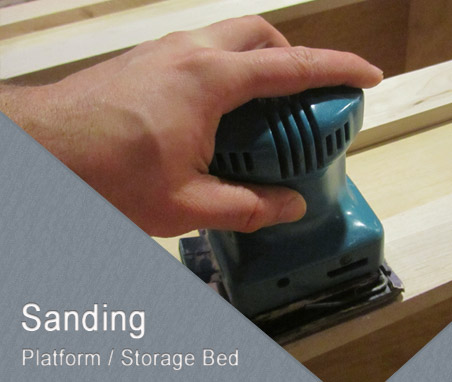People have written books on sanding & finishing, so I can’t even scratch the surface (pun intended) in this post. If you’ve never sanded wood before, I hope this will be enough to get your started. I suggest you continue your reading on the topic from other sources though.
In the previous steps of our bed frame project, we’ve put together the face frames and drawer front, then attached them to our plywood backers or drawer boxes. Unless you’re a machine, you’ll find that this process lead you with slightly “uneven” joints. If you’ve clamped properly before attaching the components, you can reduce this. In my case, however, I had purchased stock from two different suppliers. One supplier had planed the boards down to 7/8″, the other 3/4″.
 If I were smarter, I would have planed the 7/8″ board down to 3/4″ with my thickness planer. I missed this detail though, and am left with a couple face frames with very uneven joints.
If I were smarter, I would have planed the 7/8″ board down to 3/4″ with my thickness planer. I missed this detail though, and am left with a couple face frames with very uneven joints.
If you have this issue, or have ever had to sand down a considerable thickness of wood, you know how painstaking it is! We’ve introduced the thickness planer but clearly we can’t pass our entire face frame through it. My suggestion, before your first round of sanding is to purchase a cheap, powered Hand Planer![]() , and run it along your stiles that don’t line up.
, and run it along your stiles that don’t line up.
If you do end up using a hand planer, don’t be frightened by the rough finish it leaves on your wood. The next step is to sand down your components with a heavier grit sandpaper, I usually start with 60 grit. Sandpaper is expensive, especially if you purchase it in 5 packs at your local big box store. Try getting a bulk 25-pack online. I usually buy my sandpaper from hardware world. Their shipping prices have gone up a little bit lately but if you buy 2 or 3 packs, you’re still way ahead.
I like to sand my face frame stiles first, to the point that they are flush with the rails they are perpendicular to. Then, I continue to sand the rails. I use this approach because you usually end up leaving “cross-grain” scratches on the rails after sanding the stiles to bring them flush. This brings us to one of the most important techniques in sanding – sanding with the grain of the wood.
If you have a wood floor at home, think about how it might look if you dragged a metal object across it and created a huge gouge, perpendicular to the direction of the wood, and across many boards. That would be pretty noticeable, right! Now, consider that the gouge runs with the direction of the wood, far less noticeable.

The same principal applies in sanding with the grain of the wood. Sanding makes miniature scratches, and you want the scratches to go in the same direction as the grain to minimize their appearance.
 Before we switch to a finer grit sandpaper, take that 60 grit and run it along any edges that might come in contact with human hands. It’s sounds funny, but wood is sharp, especially hardwood. If you’ve gone with a shaker-style look as I have, the edges will be sharp as a knife. I’ve actually cut myself on my cabinet drawer fronts, trying to open them before they had handles.
Before we switch to a finer grit sandpaper, take that 60 grit and run it along any edges that might come in contact with human hands. It’s sounds funny, but wood is sharp, especially hardwood. If you’ve gone with a shaker-style look as I have, the edges will be sharp as a knife. I’ve actually cut myself on my cabinet drawer fronts, trying to open them before they had handles.
For this reason alone, I like give one or two passes with the 60 grit along the edges of my drawer fronts. In the case of this bed project, consider doing the same for the headboard and footboard face frames. This will not affect the appearance that much and can save you and/or your children from a painful hardwood attack!
To finish your sanding job, you may want to run another finer grit paper along your surfaces. Heavier grits tend to leave visible tracks in the wood, so are more ideal for “rough sanding”. However, don’t go too smooth; the smoother the wood, the less apt it is to retain stain. You want scratches, they hold stain, but just enough so they aren’t visible. I typically finish my wood projects with 120 grit sandpaper – hand sanded. Do you need to hand sand the final pass? I don’t know, it just seems like a nicer approach, one that ensures every movement of that sandpaper goes in the direction of the grain.
But wait, what about all that sanding dust? Sanding dust is one of the reasons I moved my workshop to the basement – it covers everything like a winter snowfall. What’s worse, is it takes hours for that dust to settle, so it has quite a bit of time to travel.
You can make a pretty rough door out of 4×8 sheet of plywood, put it on hinges and throw a latch on it. That’s both too much work and too permanent for me. I opted for a shower curtain, which goes up and comes down easily. See my post on using a shower curtain to contain workshop dust.

